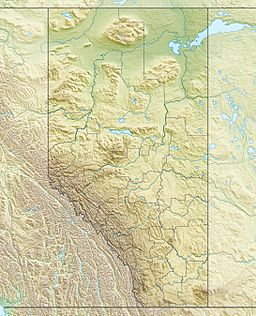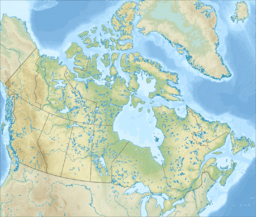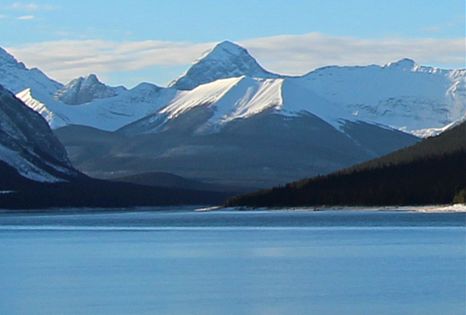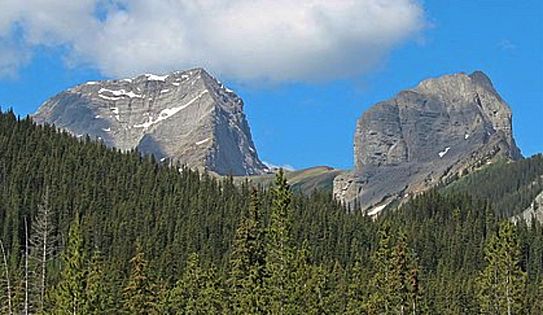Mount Smuts facts for kids
Quick facts for kids Mount Smuts |
|
|---|---|
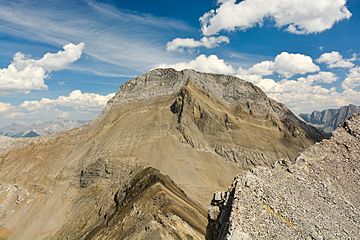
West aspect of Mount Smuts
|
|
| Highest point | |
| Elevation | 2,938 m (9,639 ft) |
| Prominence | 591 m (1,939 ft) |
| Isolation | 2.8 km (1.7 mi) |
| Parent peak | Mount Birdwood (3,097 m) |
| Listing | Mountains of Alberta |
| Geography | |
| Location | Alberta, Canada |
| Parent range | Spray Mountains Canadian Rockies |
| Topo map | NTS 82J/14 |
| Geology | |
| Age of rock | Cambrian |
| Type of rock | Limestone |
| Climbing | |
| First ascent | 1926 M. Crosby, M. Kennard, H.S. Crosby, C.A. Willard, Rudolph Aemmer |
| Easiest route | Scrambling |
Mount Smuts is a tall mountain in the Canadian Rockies of Alberta, Canada. It stands about 2,938 meters (9,639 feet) high. This mountain is located in the beautiful Spray Valley, close to the northern part of the Spray Mountains range. It sits right on the edge of two big parks: Peter Lougheed Provincial Park and Banff National Park.
You cannot see Mount Smuts from any road inside Banff Park. However, you can spot it from Alberta Highway 742. This road is also known as the Smith-Dorrien/Spray Trail in Kananaskis Country. Mount Smuts' closest taller neighbor is Mount Birdwood, which is about 2.8 kilometers (1.7 miles) to the south-southeast.
Contents
History of Mount Smuts
Mount Smuts got its name in 1918 from the Interprovincial Boundary Commission. It was named after General Jan Smuts (1870–1950). He was a very important statesman from South Africa and also enjoyed mountaineering.
During World War I, Jan Smuts led the armies of South Africa. He helped capture German South-West Africa. He also commanded the British Army in East Africa between 1916 and 1917.
The name of the mountain was officially accepted in 1924. This was done by the Geographical Names Board of Canada.
The first ascent (the first time someone successfully climbed to the top) of Mount Smuts happened in 1926. The climbers were M. Crosby, M. Kennard, H.S. Crosby, and C.A. Willard. They were guided by Rudolph Aemmer.
How Mount Smuts Was Formed
Mount Smuts is made of sedimentary rock. This type of rock forms from layers of sand, mud, and tiny bits of plants and animals that settle over time. These layers were laid down a very long time ago, between the Precambrian and Jurassic periods.
These rocks formed in shallow seas. Later, during a time called the Laramide orogeny, huge forces pushed these sedimentary rocks. They were pushed east and moved on top of younger rock layers. This process created the mountains we see today.
Weather and Climate at Mount Smuts
Mount Smuts is in a subarctic climate zone. This means it has cold, snowy winters. The summers are usually mild. Temperatures can drop below −20 °C (–4 °F). With the wind chill, it can feel even colder, sometimes below −30 °C (–22 °F).
If you want to climb, the best weather is usually from July through September. Water from the mountain flows in two directions. It drains west into the Spray River. It also drains east into Smuts Creek. Both of these waterways eventually flow into the Spray Lakes Reservoir.
Climbing Mount Smuts
Climbing Mount Smuts is considered a difficult challenge. It involves a type of climbing called Scrambling. This means you use both your hands and feet to move up steep, rocky terrain. The route goes up the south ridge, which has exposed limestone slabs.
Not many climbing groups reach the summit each year. If the weather conditions are not perfect, it is a good idea to use a rope for safety.
Gallery


